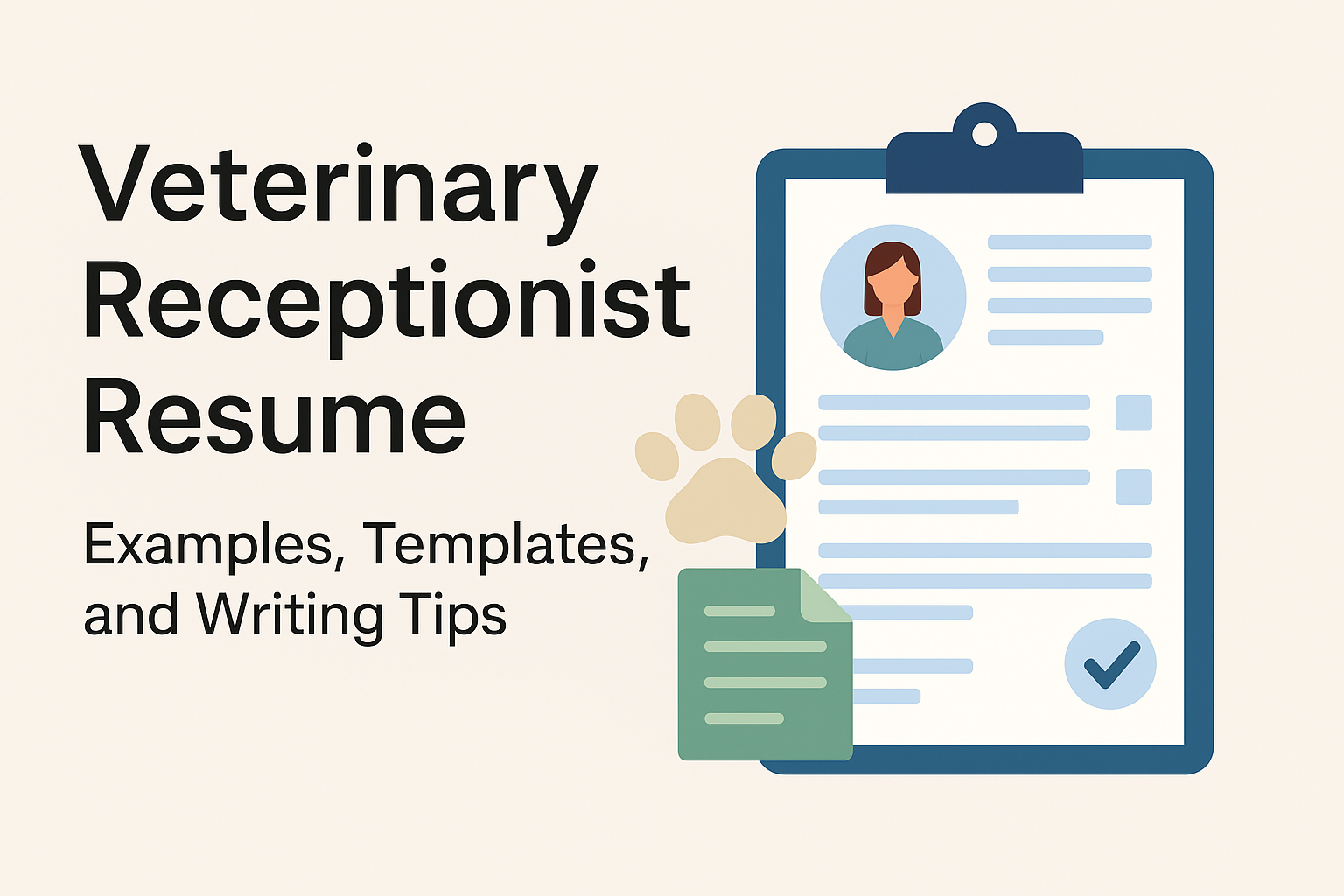In the ever-evolving field of Respiratory Therapy, having a standout resume is crucial for securing your dream job. Our collection of resume examples for Respiratory Therapist is designed to provide you with inspiration and guidance. These examples emphasize your clinical skills, patient care experience, and relevant certifications, ensuring your resume not only stands out but also effectively showcases your qualifications in a competitive job market.
Respiratory Therapist Resume Examples – Free Download
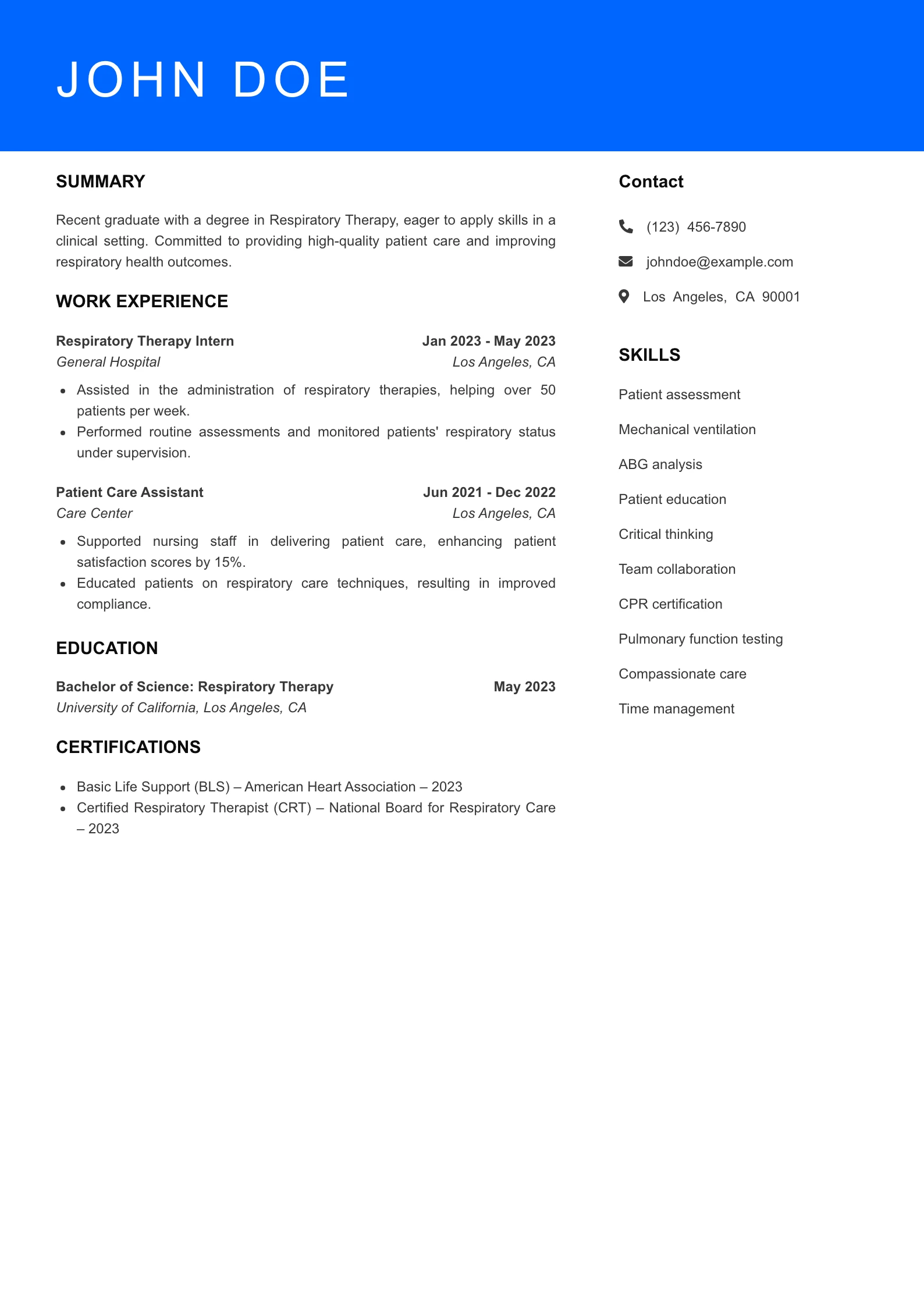

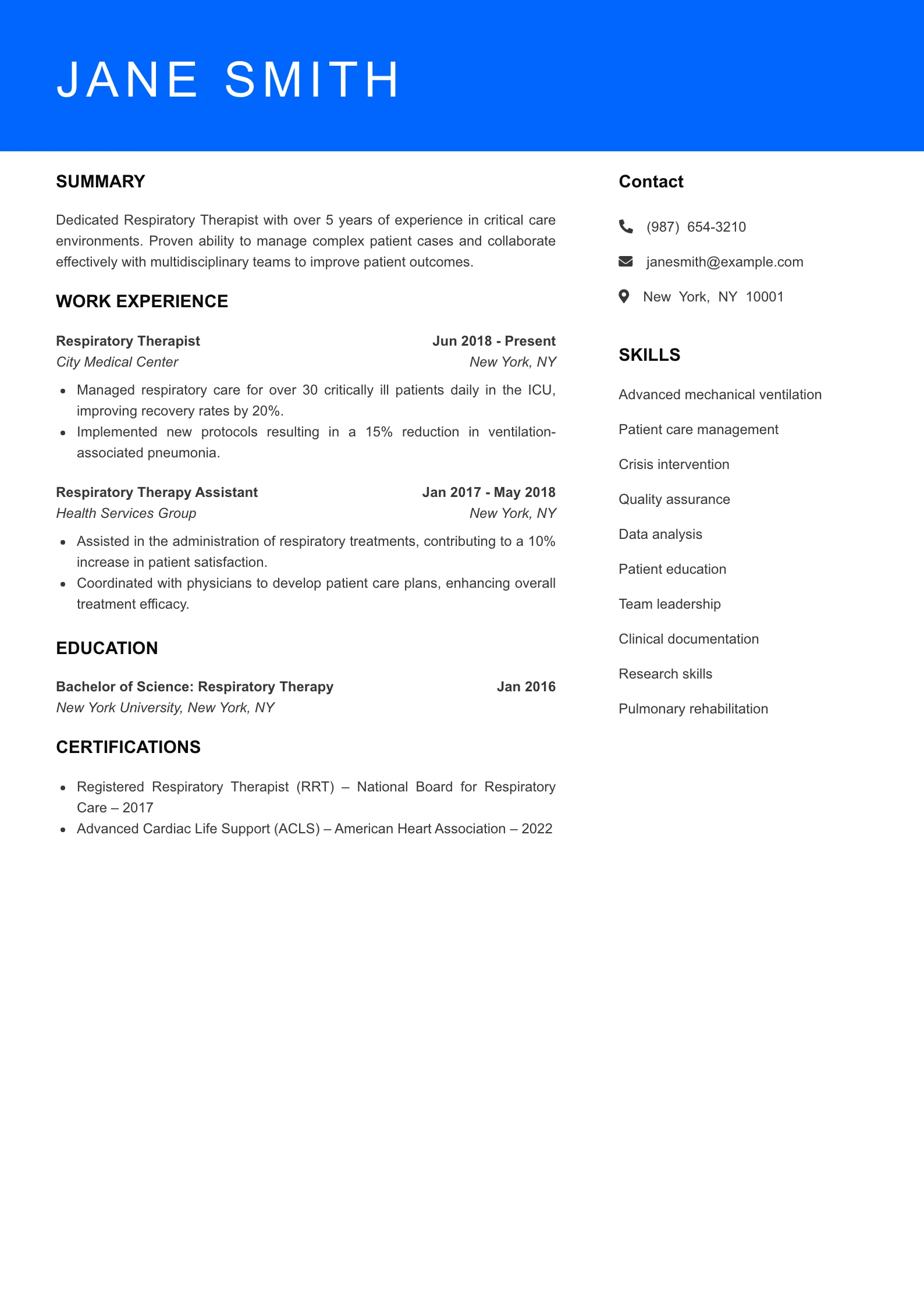

Respiratory Therapist Resume Examples
Entry Level Respiratory Therapist Resume Example
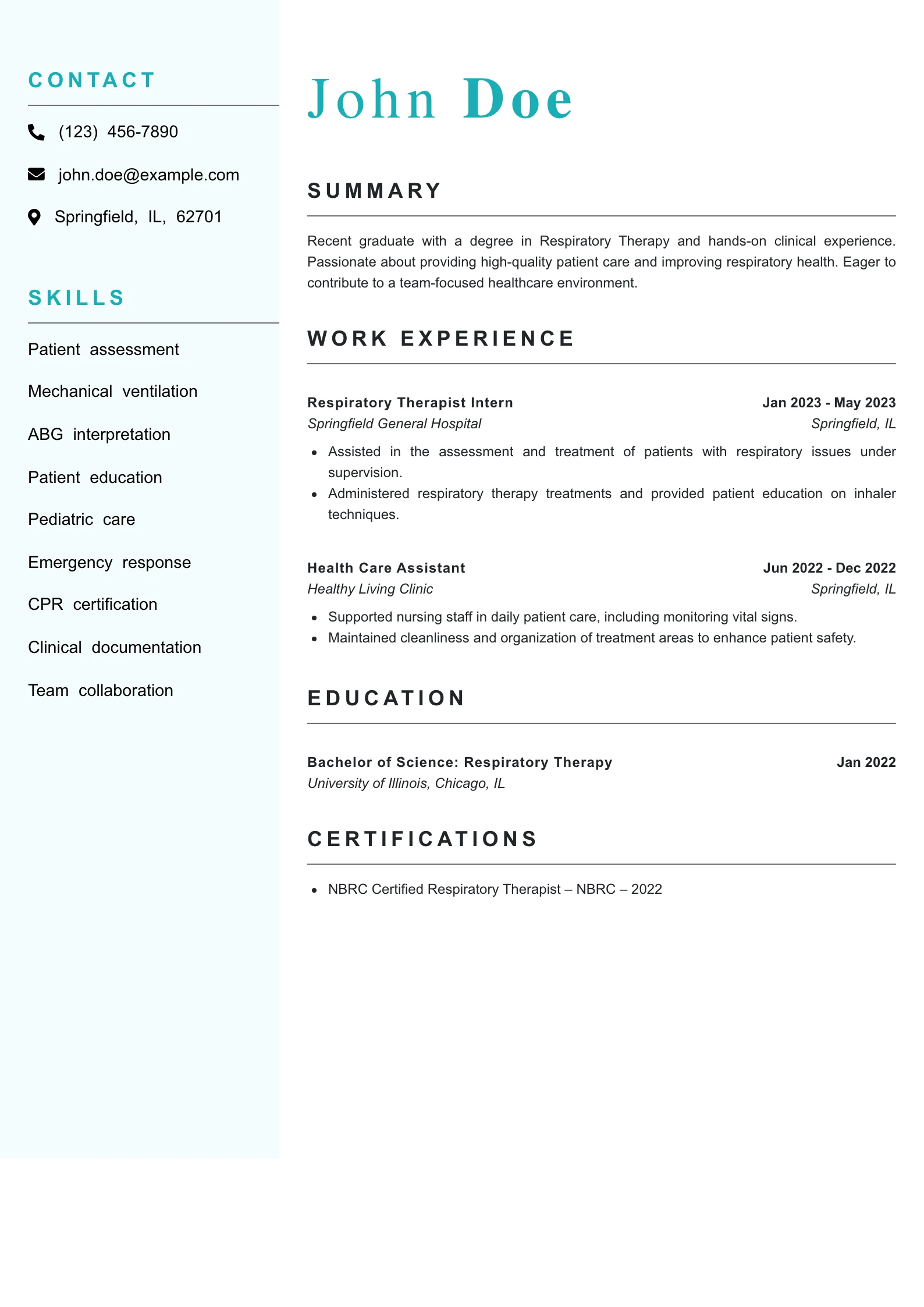
Why This Resume Works
- The summary is clear and concise, effectively highlighting John Doe’s recent graduation, degree, and passion for patient care, making it immediately relevant to healthcare employers.
- The skills listed are directly applicable to the position of a Respiratory Therapist, showcasing both technical abilities and soft skills like team collaboration, which are essential in a clinical setting.
- The work history demonstrates impactful experiences, including specific responsibilities and contributions during internships and previous roles, indicating hands-on involvement in patient care.
- This resume is well-suited for an entry-level position, as it emphasizes relevant education and clinical experience while showcasing a proactive approach to learning and professional development.
- The clarity and tone of the resume are professional, using straightforward language and a structured format that makes it easy for hiring managers to quickly assess qualifications.
Mid Level Respiratory Therapist Resume Example
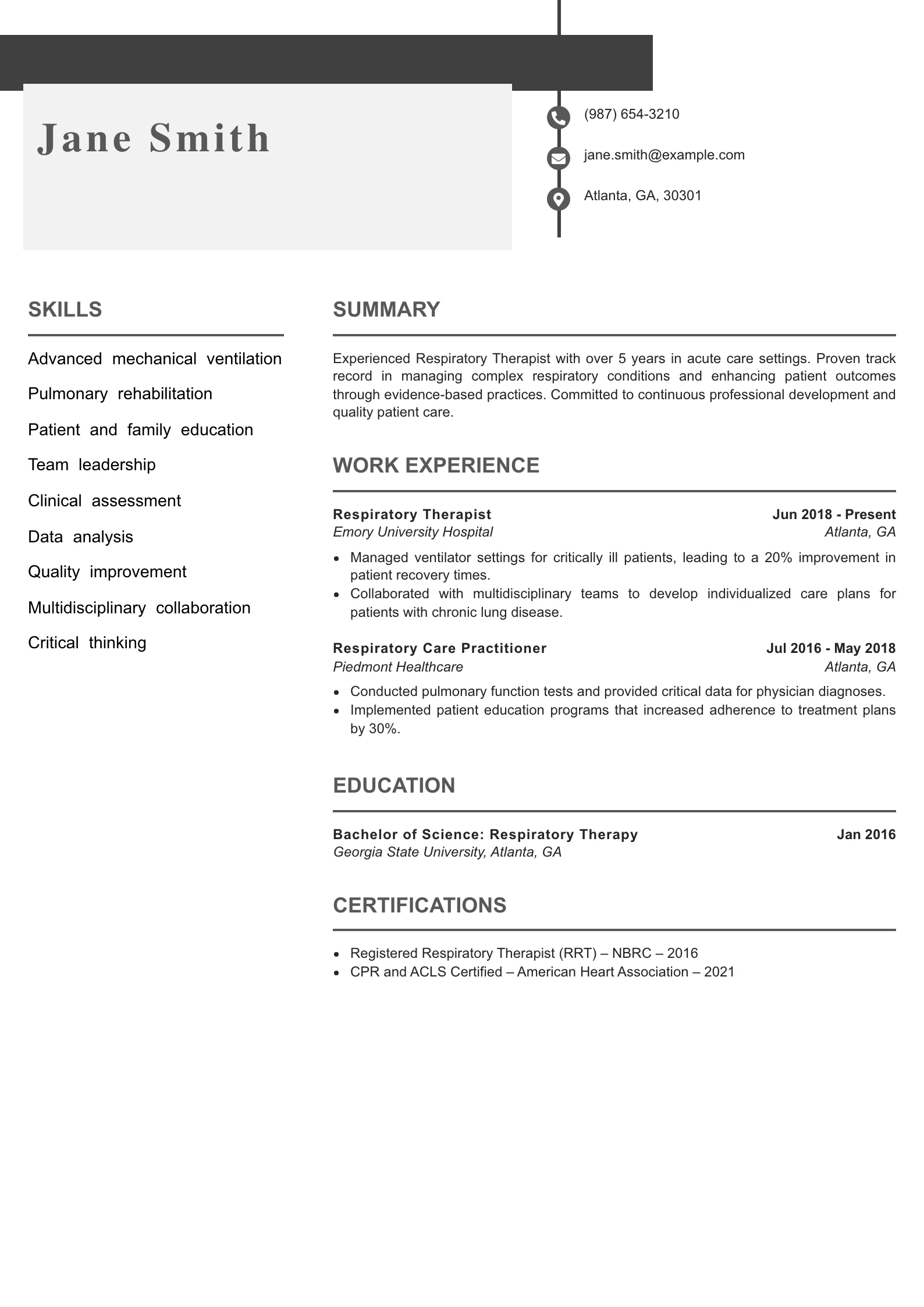
Why This Resume Works
- The summary clearly articulates Jane’s experience and commitment to quality patient care, setting a strong foundation for her expertise in respiratory therapy.
- The skills section is relevant and comprehensive, showcasing both technical expertise and soft skills that are crucial for effective patient management and teamwork.
- The work history includes quantifiable achievements, such as a 20% improvement in patient recovery times and a 30% increase in treatment adherence, demonstrating tangible impact on patient outcomes.
- The resume is tailored for a mid-level position, highlighting Jane’s progression and responsibilities that align with her experience and the expectations for a Respiratory Therapist role.
- The overall tone is professional and focused, with clear language that enhances readability and effectively communicates Jane’s qualifications and contributions to potential employers.
Senior Level Respiratory Therapist Resume Example
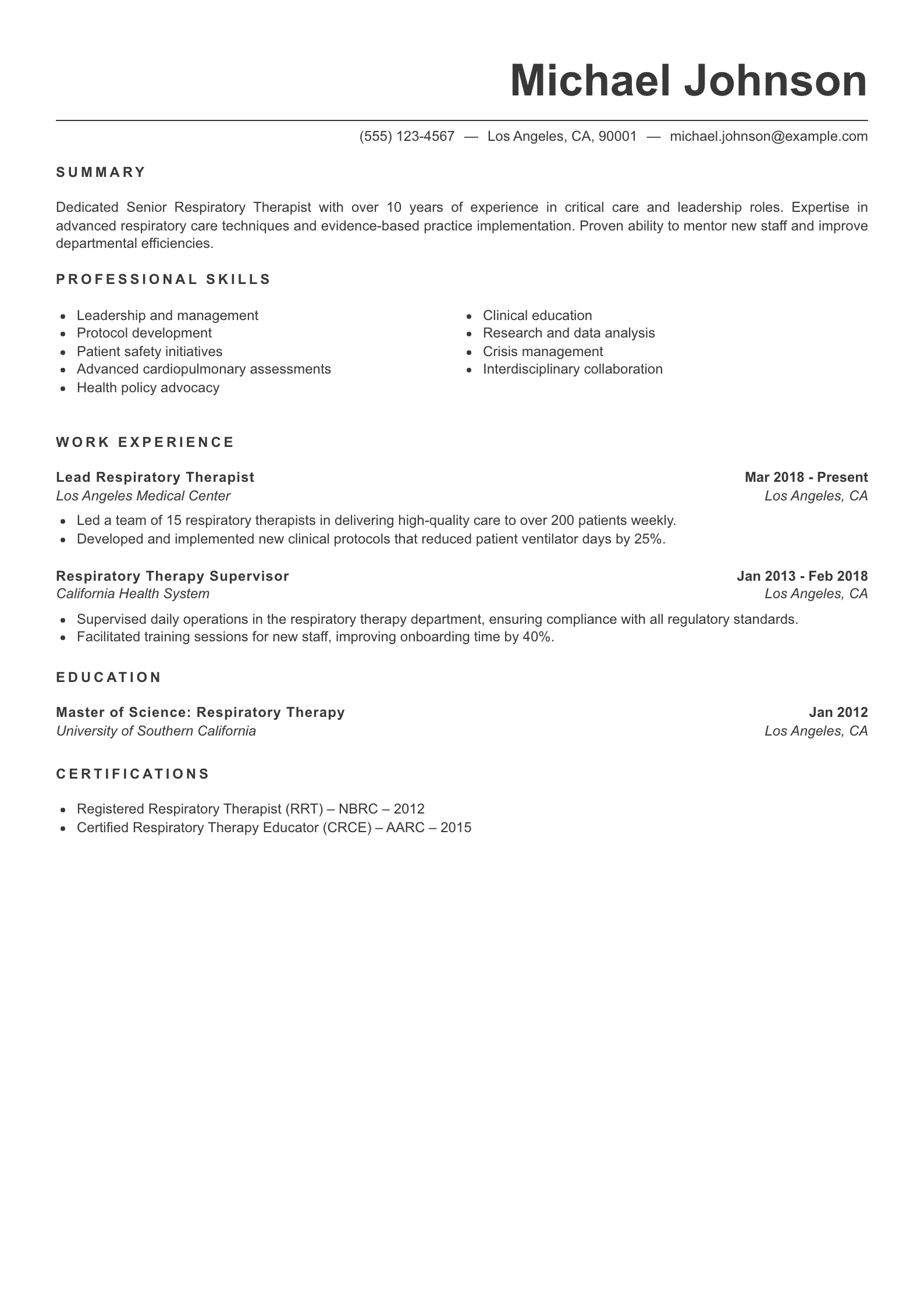
Why This Resume Works
- The summary clearly articulates Michael’s extensive experience and specific expertise in respiratory therapy, positioning him effectively as a senior-level candidate in the healthcare field.
- The skills section is comprehensive and relevant, showcasing both clinical and leadership abilities that are critical for a managerial role in respiratory therapy.
- The work history highlights impactful achievements, such as reducing patient ventilator days and improving onboarding time, demonstrating measurable contributions to departmental efficiencies.
- The resume is tailored for a senior position, evident through the leadership roles and responsibilities outlined, which align with the expectations for a candidate at this level.
- The clarity and professional tone of the resume convey a strong sense of confidence and competence, making it appealing to hiring managers in the healthcare industry.
How to Craft a Strong Respiratory Therapist Resume
Creating a compelling resume is crucial for Respiratory Therapists aiming to stand out in a competitive job market. Hiring managers in healthcare look for candidates who not only possess the required technical skills but also demonstrate the ability to provide compassionate patient care. This guide will help you effectively highlight your strengths and qualifications, ensuring your resume captures the attention of potential employers.
1. Summary Statement
A strong summary statement is your chance to make a positive first impression on hiring managers. It serves as your elevator pitch, encapsulating your experience, specialization, and key strengths in a concise paragraph. An effective summary should clearly state your experience level and any relevant certifications while emphasizing soft skills that contribute to your effectiveness as a Respiratory Therapist.
When crafting your summary, aim for a confident and tailored tone that focuses on results. Use language that showcases your commitment to patient care and your ability to handle diverse respiratory challenges. Consider including specific metrics or achievements that reflect your qualifications.
Compassionate recent Respiratory Therapy graduate with clinical experience in acute settings, dedicated to providing top-notch care to diverse patient populations. Eager to leverage strong assessment skills and a commitment to ongoing professional development.
Mid-Level:
Dedicated Respiratory Therapist with over 5 years of experience in critical care environments. Proven track record of improving patient outcomes through innovative treatment plans and effective collaboration with healthcare teams.
2. Skills & Qualifications
Highlighting the right skills is essential for demonstrating your qualifications as a Respiratory Therapist. Core skills to include are technical competencies like mechanical ventilation and pulmonary function testing, along with soft skills such as empathy, communication, and teamwork.
To identify the most relevant skills, analyze job descriptions for keywords and phrases that align with your expertise. This will ensure that your resume is appealing to both hiring managers and Applicant Tracking Systems (ATS).
- Mechanical ventilation
- Pulmonary function testing
- Patient education
- Crisis management
- Team collaboration
- Electronic Health Records (EHR)
- Clinical assessment
- Critical thinking
Top ATS Keywords for Respiratory Therapist
3. Work History
In the Work History section, focus on showcasing your patient care experiences, leadership roles, and specialized procedures relevant to your level of expertise. Use a reverse-chronological format to highlight your most recent roles first.
Utilize quantified bullet points to effectively convey your contributions and the impact of your work. This not only demonstrates your capabilities but also provides tangible evidence of your success in previous positions.
Intern, City Hospital, Anytown, ST, June 2022 – Aug 2022
– Assisted in administering respiratory therapies to patients with diverse needs.
– Conducted routine checks on ventilators and other respiratory equipment.
– Collaborated with nursing staff to ensure comprehensive patient care.
Mid-Level:
Respiratory Therapist, General Medical Center, Anytown, ST, Jan 2019 – Present
– Developed and implemented individualized care plans for respiratory patients, resulting in a 20% reduction in ICU admissions.
– Mentored new staff on best practices for patient assessment and therapy administration.
– Led training sessions on the use of advanced respiratory technologies.
4. Education
A strong educational background is essential for a Respiratory Therapist. Typically, candidates hold an Associate’s or Bachelor’s degree in Respiratory Therapy or a related field, accompanied by necessary certifications.
When formatting your educational qualifications, list your degree, institution name, and graduation year clearly. Be sure to include any relevant certifications that enhance your qualifications and set you apart from other applicants.
Degree, School Name, City, State, Graduation Year
Example:
BS in Respiratory Therapy, University of Health Sciences, Anytown, ST, 2021
5. Additional Sections
Consider adding optional sections to your resume that can make it more comprehensive, such as Certifications, Languages, and Awards. Including certifications relevant to the field, like the Registered Respiratory Therapist (RRT) credential, adds credibility to your qualifications.
When listing certifications, format them clearly, including the certifying body and the year obtained. This not only showcases your commitment to continuous learning but also highlights your compliance with industry standards.
- Registered Respiratory Therapist (RRT) – National Board for Respiratory Care – 2022
- Basic Life Support (BLS) Certification – American Heart Association – 2021
6. Do’s and Don’ts
To ensure your Respiratory Therapist resume stands out for the right reasons, keep these practical tips in mind:
Do:
- Tailor your resume for ATS by using industry keywords.
- Showcase the impact of your work through metrics and achievements.
- Use specific industry terms to demonstrate your knowledge.
Don’t:
- Use generic statements that lack personalization.
- Underestimate the importance of soft skills in patient care.
- Overuse buzzwords that may dilute your message.



